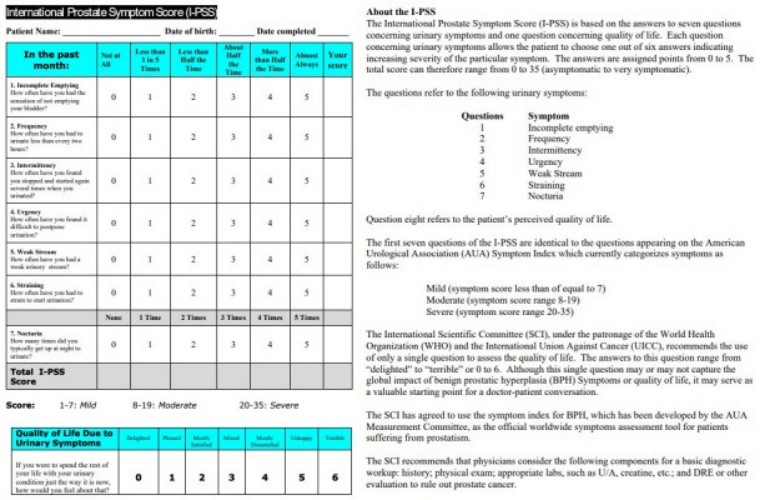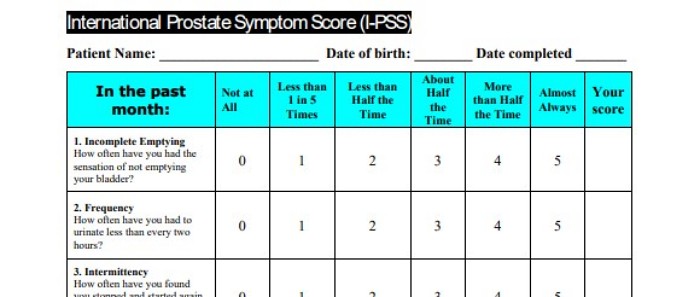International Prostate Symptom Score to assess BPH symptom severity: A reliable tool for evaluating urinary issues in men.
The International Prostate Symptom Score (IPSS) is a valuable tool for assessing the severity of benign prostatic hyperplasia (BPH) symptoms. This eight-question screening tool helps diagnose, track, and manage urinary symptoms associated with BPH, providing crucial information for both patients and healthcare providers.

The IPSS questionnaire covers various aspects of urinary function, including frequency, urgency, and nocturia. Patients rate their symptoms on a scale from 0 to 5, with higher scores indicating more severe symptoms. The total score, ranging from 0 to 35, helps classify BPH severity as mild, moderate, or severe.
By using the IPSS, healthcare professionals can better understand a patient’s urinary symptoms and quality of life. This information guides treatment decisions and allows for monitoring of symptom progression over time, ensuring that patients receive appropriate care tailored to their individual needs.
Key Takeaways
- The IPSS is an essential tool for assessing BPH symptom severity and guiding treatment decisions
- Scores range from 0 to 35, categorizing symptoms as mild, moderate, or severe
- Regular use of the IPSS helps monitor symptom progression and evaluate treatment effectiveness
- Similar to the AUA Symptom Index (first 7 questions)
Understanding BPH and Its Impact
Benign prostatic hyperplasia (BPH) is a common urinary condition that affects many men as they age. It can lead to bothersome lower urinary tract symptoms and impact quality of life.
Overview of Benign Prostatic Hyperplasia
BPH refers to the non-cancerous enlargement of the prostate gland. As men get older, the prostate often grows larger, which can compress the urethra and cause urinary issues.
Common symptoms include:
- Frequent urination, especially at night
- Weak urine stream
- Difficulty starting urination
- Feeling of incomplete bladder emptying
BPH typically develops gradually over years. While not life-threatening, it can significantly affect daily activities and sleep patterns if left untreated.
Risk factors include age, family history, and certain medical conditions like obesity and diabetes. Lower urinary tract symptoms due to BPH become increasingly prevalent in men over 50.
Evaluating the Severity of BPH Symptoms
Assessing symptom severity is crucial for proper BPH management. Doctors use standardized questionnaires to evaluate symptoms objectively.
The International Prostate Symptom Score (IPSS) is widely used to quantify BPH symptoms. It includes questions about:
- Urinary frequency
- Urgency
- Nocturia
- Weak stream
- Straining
- Incomplete emptying
Patients rate each symptom on a scale of 0-5. The total score helps determine symptom severity:
- Mild: 0-7 points
- Moderate: 8-19 points
- Severe: 20-35 points
Regular use of symptom scores allows doctors to track changes over time and assess treatment effectiveness.
Impact on Quality of Life and Urinary Function
BPH can significantly affect a man’s quality of life and urinary function. Frequent urination, especially at night, can disrupt sleep and daily activities.
Some men may experience:
- Anxiety about finding bathrooms
- Embarrassment about urinary symptoms
- Reduced social activities
- Decreased work productivity
Severe cases can lead to complications like urinary retention, bladder stones, or kidney damage. Quality of life assessments are often used alongside symptom scores to gauge the full impact of BPH.
Treatment options range from lifestyle changes to medications and surgical interventions. The goal is to alleviate symptoms and improve overall urinary function and quality of life.
IPSS as a Diagnostic and Management Tool
The International Prostate Symptom Score (IPSS) serves as a valuable tool in diagnosing and managing benign prostatic hyperplasia (BPH). It provides a standardized method for assessing symptom severity and guiding treatment decisions.
Understanding the IPSS and Its Components

The IPSS consists of seven questions that evaluate lower urinary tract symptoms (LUTS) associated with BPH. These questions cover incomplete emptying, frequency, intermittency, urgency, weak stream, straining, and nocturia. Each question is scored from 0 to 5, with higher scores indicating more severe symptoms.
The total IPSS score ranges from 0 to 35, categorizing symptom severity as:
- Mild (0-7 points)
- Moderate (8-19 points)
- Severe (20-35 points)
An additional quality of life question assesses the patient’s overall satisfaction with their urinary symptoms.
Note: If you would like to take the IPSS test followed by the EPIC-26 (Expanded Prostate Cancer Index Composite) and the SHIM (Sexual Health Inventory For Men).
The Basic IPSS test is located in the section below.
Once completed you can download and save the document to your computer.
Administering and Interpreting the IPSS
The Basic IPSS test is typically self-administered by the patient, making it easy to use in clinical settings. Patients answer questions based on their experiences over the past month, providing a comprehensive picture of their symptoms.
Urologists and healthcare providers interpret the scores to determine the severity of BPH symptoms and track changes over time. It’s important to note that while the IPSS is a powerful screening tool, it should be used in conjunction with other diagnostic methods for a complete evaluation.
Regular administration of the IPSS can help monitor disease progression and treatment efficacy.
Utilizing IPSS in BPH Treatment Decisions
The IPSS plays a crucial role in guiding BPH treatment decisions. For patients with mild symptoms (scores 0-7), watchful waiting may be appropriate. Moderate symptoms (scores 8-19) often warrant medical therapy, while severe symptoms (scores 20-35) may require more aggressive interventions.
The American Urological Association recommends using the IPSS for objective assessment of symptoms at initial contact, follow-up during watchful waiting, and evaluation of treatment response. Changes in IPSS scores can help determine the effectiveness of treatments and guide decisions on whether to maintain, adjust, or change management strategies.
By providing a standardized measure of symptom severity, the IPSS enables urologists to make informed, patient-centered treatment decisions for BPH management.
Frequently Asked Questions

The International Prostate Symptom Score (IPSS) is a valuable tool for assessing and monitoring benign prostatic hyperplasia (BPH) symptoms. It provides important insights into symptom severity and helps guide treatment decisions.
How do you calculate the International Prostate Symptom Score (IPSS) for evaluating urinary symptoms?
The IPSS is calculated by summing the scores from seven questions about urinary symptoms. Each question is rated on a scale of 0-5, with 0 indicating no symptoms and 5 indicating severe symptoms.
The total score ranges from 0-35. Questions assess symptoms such as incomplete emptying, frequency, intermittency, urgency, weak stream, straining, and nocturia.
What does each range of the IPSS indicate about the severity of benign prostatic hyperplasia (BPH) symptoms?
The IPSS categorizes BPH symptom severity into three ranges:
- 0-7: Mild symptoms
- 8-19: Moderate symptoms
- 20-35: Severe symptoms
These ranges help clinicians assess the impact of BPH on a patient’s quality of life and determine appropriate treatment options.
How is the American Urological Association (AUA) symptom index related to the IPSS?
The AUA Symptom Index is identical to the first seven questions of the IPSS. Both tools use the same scoring system and symptom severity categories.
The IPSS includes an additional quality of life question, making it a slightly more comprehensive assessment tool for BPH symptoms.
What treatment options are influenced by a patient’s IPSS?
A patient’s IPSS helps guide treatment decisions for BPH. Mild symptoms (0-7) may be managed with watchful waiting and lifestyle changes.
Moderate symptoms (8-19) might warrant medical therapy. Severe symptoms (20-35) may require more aggressive treatments, including minimally invasive procedures or surgery.
Can you explain the scoring system for the IPSS and what the individual questions assess?
The IPSS consists of seven questions, each scored from 0-5. Questions evaluate:
- Incomplete emptying
- Frequency
- Intermittency
- Urgency
- Weak stream
- Straining
- Nocturia
An eighth question assesses quality of life related to urinary symptoms, scored from 0-6.
How often should the IPSS be administered to monitor symptom progression in BPH?
The frequency of IPSS administration varies based on individual patient needs and treatment plans. Generally, it is recommended to administer the IPSS:
- At initial diagnosis
- Before starting treatment
- During follow-up visits to assess treatment efficacy
- Annually for patients on stable treatment regimens
More frequent assessments may be necessary for patients with rapidly progressing symptoms or those undergoing treatment adjustments.

